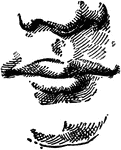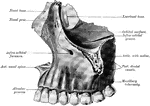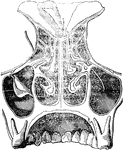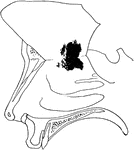Clipart tagged: ‘nose’

Gar
"Two feet long, with the under jaw greatly protruded; it swims near the surface; bites at a hook; makes…

Section of the Head and Neck
Sagittal section through mouth, tongue, larynx, pharynx, and nasal cavity. The section was slightly…

Mouth
"The mouth, nose and pharynx, with the commencement of the gullet and larynx, as exposed by a section,…

The Mouth, Nose, and Pharynx
The mouth, nose, and pharynx, with the commencement of gullet (esophagus) and larynx, as exposed by…

The Mouth, Nose, and Pharynx
The mouth, nose, and pharynx, with the larynx and commencement of gullet (esophagus), seen in section.…

The Mouth, Nose, and Pharynx
The mouth, nose, and pharynx, with the commencement of the gullet (esophagus) and larynx, as exposed…
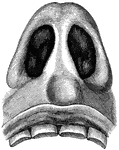
Nasal cavities
"Nasal Cavities, seen from Below. The sense of smell is located in the membrane which lines the cavities…
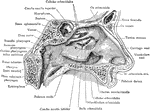
Nasal Cavity
The lateral wall of the left nasal cavity. The greater part of the middle turbinated bone has been excised…
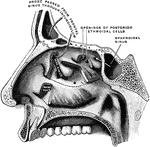
External Wall of Nasal Cavity
External wall of right nasal fossa, parts of the turbinates having been cut away to show the orifices…
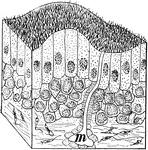
Section of Nasal Tissue
"A tiny block of tissue from the membrane lining the inner surface of the nose. Note the hundreds of…
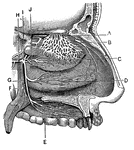
Nerves of the Nostril
"A, branches of the nerves of smell; B, nerves of touch to the nostrils; E, F,…
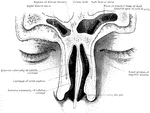
Section Through Nose and Frontal Sinuses
Vertical coronal section through the nose and frontal sinuses.

Outer Wall of Nose
View of the outer wall of the nose. The turbinated bones having been removed. Labels: 1, vestibule,…
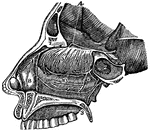
A Side View of the Passage of the Nostrils
A side view of the passage of the nostrils. 4, The distribution of the first olfactory pair of nerves.…
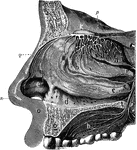
Olfactory System
The olfactory system. Labels: a, b, c, d, interior of the nose, which is lined by a mucous membrane;…
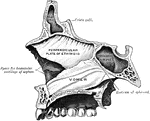
Vomer
The vomer is a single bone, situated vertically at the back part of the nasal fossae, forming part of…

Human Vomer Nasal Bone
Vomer bone, a single bone placed at the back part of the nasal cavity, and forms part of the septum…
